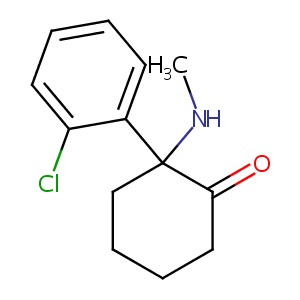| 1 |
FDA Drug Development and Drug Interactions
|
| 2 |
FDA Approved Drug Products from FDA Official Website. 2019. Application Number: (ANDA) 076092.
|
| 3 |
Ketamine FDA Label
|
| 4 |
ClinicalTrials.gov (NCT04365985) Study of Immunomodulation Using Naltrexone and Ketamine for COVID-19. U.S. National Institutes of Health.
|
| 5 |
URL: http://www.guidetopharmacology.org Nucleic Acids Res. 2015 Oct 12. pii: gkv1037. The IUPHAR/BPS Guide to PHARMACOLOGY in 2016: towards curated quantitative interactions between 1300 protein targets and 6000 ligands. (Ligand id: 200).
|
| 6 |
Amitriptyline FDA Label
|
| 7 |
Ketamine-induced bladder fibrosis involves epithelial-to-mesenchymal transition mediated by transforming growth factor-1. Am J Physiol Renal Physiol. 2017 Oct 1;313(4):F961-F972. doi: 10.1152/ajprenal.00686.2016. Epub 2017 Mar 22.
|
| 8 |
Ketamine modulates theta and gamma oscillations. J Cogn Neurosci. 2010 Jul;22(7):1452-64.
|
| 9 |
Contribution of CYP3A4, CYP2B6, and CYP2C9 isoforms to N-demethylation of ketamine in human liver microsomes. Drug Metab Dispos. 2002 Jul;30(7):853-8.
|
| 10 |
Cytoskeleton interruption in human hepatoma HepG2 cells induced by ketamine occurs possibly through suppression of calcium mobilization and mitochondrial function. Drug Metab Dispos. 2009 Jan;37(1):24-31.
|
| 11 |
Ketamine hypertension and the renin-angiotensin system. Clin Exp Hypertens A. 1983;5(6):875-83. doi: 10.3109/10641968309081814.
|
| 12 |
Cellular consequences triggered by ketamine on exposure to human glioblastoma epithelial (LN-229) cells. J Biochem Mol Toxicol. 2023 Dec;37(12):e23484. doi: 10.1002/jbt.23484. Epub 2023 Jul 29.
|
| 13 |
Ketamine cystitis as a mimic of carcinoma in situ. Histopathology. 2009 Dec;55(6):705-8. doi: 10.1111/j.1365-2559.2009.03437.x.
|
| 14 |
Ketamine promotes the amyloidogenic pathway by regulating endosomal pH. Toxicology. 2022 Apr 15;471:153163. doi: 10.1016/j.tox.2022.153163. Epub 2022 Apr 1.
|
| 15 |
Lipoxin A4 methyl ester attenuated ketamine-induced neurotoxicity in SH-SY5Y cells via regulating leptin pathway. Toxicol In Vitro. 2023 Jun;89:105581. doi: 10.1016/j.tiv.2023.105581. Epub 2023 Mar 11.
|
| 16 |
Apoptotic insults to human HepG2 cells induced by S-(+)-ketamine occurs through activation of a Bax-mitochondria-caspase protease pathway. Br J Anaesth. 2009 Jan;102(1):80-9. doi: 10.1093/bja/aen322. Epub 2008 Nov 9.
|
| 17 |
The apolipoprotein E epsilon 4 allele is associated with blunting of ketamine-induced psychosis in schizophrenia. A preliminary report. Neuropsychopharmacology. 1998 Nov;19(5):445-8. doi: 10.1016/S0893-133X(98)00031-1.
|
| 18 |
Treatment of comorbid pain with serotonin norepinephrine reuptake inhibitors. CNS Spectr. 2008 Jul;13(7 Suppl 11):22-6.
|
| 19 |
Caco-2 permeability, P-glycoprotein transport ratios and brain penetration of heterocyclic drugs. Int J Pharm. 2003 Sep 16;263(1-2):113-22.
|
| 20 |
Bioactivation of the tricyclic antidepressant amitriptyline and its metabolite nortriptyline to arene oxide intermediates in human liver microsomes and recombinant P450s. Chem Biol Interact. 2008 May 9;173(1):59-67.
|
| 21 |
The genetic profiles of CYP1A1, CYP1A2 and CYP2E1 enzymes as susceptibility factor in xenobiotic toxicity in Turkish population. Saudi Pharm J. 2017 Feb;25(2):294-297.
|
| 22 |
Liquid chromatography-tandem mass spectrometry method for measurement of nicotine N-glucuronide: a marker for human UGT2B10 inhibition. J Pharm Biomed Anal. 2011 Jul 15;55(5):964-71.
|
| 23 |
Effects of cytochrome b(5) on drug oxidation activities of human cytochrome P450 (CYP) 3As: similarity of CYP3A5 with CYP3A4 but not CYP3A7. Biochem Pharmacol. 2003 Dec 15;66(12):2333-40.
|
| 24 |
Five distinct human cytochromes mediate amitriptyline N-demethylation in vitro: dominance of CYP 2C19 and 3A4. J Clin Pharmacol. 1998 Feb;38(2):112-21.
|
| 25 |
The xenobiotic inhibitor profile of cytochrome P4502C8. Br J Clin Pharmacol. 2000 Dec;50(6):573-80.
|
| 26 |
Cytochromes P450 mediating the N-demethylation of amitriptyline. Br J Clin Pharmacol. 1997 Feb;43(2):137-44.
|
| 27 |
Application of the relative activity factor approach in scaling from heterologously expressed cytochromes p450 to human liver microsomes: studies on amitriptyline as a model substrate. J Pharmacol Exp Ther. 2001 Apr;297(1):326-37.
|
| 28 |
A study on CYP2C19 and CYP2D6 polymorphic effects on pharmacokinetics and pharmacodynamics of amitriptyline in healthy Koreans. Clin Transl Sci. 2017 Mar;10(2):93-101.
|
| 29 |
ADReCS-Target: target profiles for aiding drug safety research and application. Nucleic Acids Res. 2018 Jan 4;46(D1):D911-D917. doi: 10.1093/nar/gkx899.
|
| 30 |
ABCB1 gene variants influence tolerance to selective serotonin reuptake inhibitors in a large sample of Dutch cases with major depressive disorder. Pharmacogenomics J. 2013 Aug;13(4):349-53.
|
|
|
|
|
|
|


